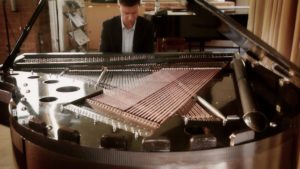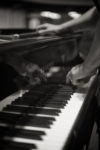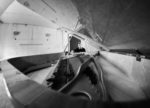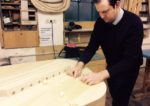Piano Maker’s Corner: Cristofori’s Piano Revolution Lives On
 Bartolomeo Cristofori. Is that a significant name to you? As a “Piano Addict“, it really should be! It is said that somewhere between the 1700’s and 1720’s, Cristofori invented a new instrument. So radical was this instrument that it was not immediately given a proper name, rather a description. (It is thought that other instrument makers created similar percussion keyboard instruments around the same time, but in the history books, Cristofori got the credit for having done it first.)
Bartolomeo Cristofori. Is that a significant name to you? As a “Piano Addict“, it really should be! It is said that somewhere between the 1700’s and 1720’s, Cristofori invented a new instrument. So radical was this instrument that it was not immediately given a proper name, rather a description. (It is thought that other instrument makers created similar percussion keyboard instruments around the same time, but in the history books, Cristofori got the credit for having done it first.)
An entry in the diary of a Italian court musician said the following: “An Arpicembalo by Bartolomeo Cristofori, of new invention that produces soft and loud, with two sets of strings at unison pitch, with soundboard of cypress without rose…” The “Arpicembalo” literally meant a “Harp-harpsichord”, but the description of this being played “soft and loud” tells us exactly what Cristofori had done. He had invented the piano. The world of music was to change forever.
Did Cristofori know that what he had invented would one day be one of the most popular and widely used instruments on earth? Perhaps not. Did he believe his Pianoforte, as it would be later be known, would be an instant hit? Well, it wasn’t. Harpsichord purists hated it. They called it “too soft” and “dull”. Was this unpopularity to last? Would the harpsichord continue to be the keyboard instrument of choice? Well, ask yourself – how many readers are there for Harpsichord Addict?
popular and widely used instruments on earth? Perhaps not. Did he believe his Pianoforte, as it would be later be known, would be an instant hit? Well, it wasn’t. Harpsichord purists hated it. They called it “too soft” and “dull”. Was this unpopularity to last? Would the harpsichord continue to be the keyboard instrument of choice? Well, ask yourself – how many readers are there for Harpsichord Addict?
Of course, in the following three centuries there are been updates to Cristifori’s original design, mainly in the use of new materials. One of the biggest changes perhaps, is the use of a cast iron frame in order to hold the strings at pitch. A wooden frame is, of course, nowhere near strong enough to hold this enormous amount of tension for any length of time, so had to be replaced with a material with better properties for the job. This major improvement though, was apparently first submitted for patent by Alpheus Babcock way back in 1825.
In the last 100 years however, when we have managed to advance technology in almost all areas of life, the design of the piano has changed very little, if at all. In fact, many manufacturers still build their modern pianos to the exact same design that they were using when World War One was raging.
“That’s because the piano is perfect!” I hear you Addicts cry. But is it?
The piano is a wonderful instrument. I have devoted my entire career to working with pianos because I love them so much. I also feel though that we cannot say that any design, of any one object, is perfect. Can a 100+ year old design of a complex instrument, before computer analysis and other technological advances were around to aid the design, be 100% perfect? For definite? It’s a thought provoking question.
When I met Richard Dain of Phoenix Pianos, I was as skeptical as could be about using new materials in a piano, especially for the heart and soul of the instrument – the soundboard. I went to the showroom ready to dislike! I found though, that using carbon fibre (CF) as a soundboard material has to be heard in person to be believed. I find that unless someone is told they are playing a piano with a CF soundboard, they are unable to identify that there is any difference between it and one with a traditional spruce soundboard. Any difference that can be heard can usually be eradicated with voicing of the hammers (you can read more about this here).
What are the reasons for replacing wood as the material for a soundboard? Carbon fibre is unbelievably strong, can be made incredibly thin and will last for hundreds and hundreds of years. Also, it is totally unaffected by changes in humidity, even at extreme levels. All of this results in a soundboard that will never split, won’t be the reason your piano goes out of tune (unlike the constantly expanding and contracting wooden soundboard in a traditional piano) and can be made as thin as required to achieve the perfect tonal quality.
Surely that’s worth trying, isn’t it?
Of course, Phoenix aren’t the only company using new materials to piano design. Wessel, Nickel & Gross (WNG) have been making wonderful carbon fibre and composite actions in the USA for some years now. There is no doubt in my mind that carbon fibre parts are the future of the piano action. The strength of CF means no “flex” in the hammer shanks, which means virtually no energy loss between your finger tips and the string, giving the artist more control and a more immediate sound. Again, humidity doesn’t affect these actions, so no more sticking keys! Also, regulation lasts much longer with a carbon fibre action, so less servicing (not such good news for us piano technicians!).
Note: Other manufacturers use carbon fibre in their actions. However, most continue to make the hammer shank from wood. This is the area most affected by “flex”, where much of the energy from the finger is lost due to the shank bending before it strikes the string! For a true feel of a CF action, ensure the shank is made from a composite material too.
Changes to the piano are not limited to materials. DG Devices, based in Kansas City, Missouri, have developed the self tuning piano. Check it out here (http://dgdevices.com). This incredible feat of engineering uses temperature changes to alter the pitch of each individual string, tuning the whole piano in just two minutes. Piano tuners watch out (Myself included)!
Regular Piano Addict readers may already know that here at Phoenix Pianos we’ve built a prototype all-carbon fibre piano (frame and all), called the Carbiano. You can watch some videos of this piano being played here (http://www.phoenixpianos.co.uk/phoenix-carbiano-9/)
In a Piano Addict exclusive, I am pleased to announce that Phoenix Pianos plans to go into production with a new range of SIX carbon fibre grand piano models, from 170cm baby grand up to a 290cm Concert grand.
This range of Carbiano models will be truly climate resistant, super light-weight (our prototype baby grand can be easily carried across a room by two people), fitted with carbon fibre actions and the latest and highest quality self playing systems. This really could be the future of piano design.
The piano is undergoing to incredible changes during this technological age we live in. We’re very excited to be involved with what can only be described as “The Piano Revolution”!
So how will you react if you’re invited to play a piano with a CF soundboard or action, or maybe some other new technology? Will you react like the purist harpsichord players of Cristofori’s era? Or will you be open to trying something new?
Go on, give it a go. You never know, you might just like it…


